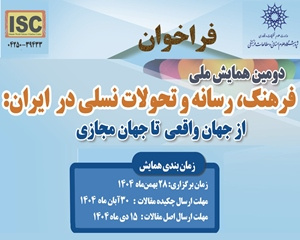بررسی رابطه هوش معنوی و نوع دین داری (مطالعه موردی: جوانان شهر یزد) (مقاله علمی وزارت علوم)
درجه علمی: نشریه علمی (وزارت علوم)
آرشیو
چکیده
به نظر می رسد می توان هوش معنوی را به عنوان مهارتی در تفسیر رویدادها و کشف معنای زندگی و حل مسائل، در ارتباط با زیست دینی دانست. هدف این پژوهش، بررسی رابطه هوش معنوی با نوع دین داری جوانان با کمک نظریه تکثر زیست جهان ها و استعاره بازار برگر و هوش معنوی ایمونز است. ابزار این پژوهش، پرسشنامه محقق ساخته ای بوده که اعتبار آن از طریق اعتبار محتوا و پایایی آن از طریق آلفای کرون باخ تأیید شده است. 384 نفر از جوانان 15 تا 34 ساله شهر یزد با کمک نمونه گیری خوشه ای چندمرحله ای انتخاب شده اند. داده ها با نرم افزار spss و تحلیل عاملی و آزمون های ,t f، ضریب همبستگی و تحلیل مسیر تحلیل شدند. یافته ها نشان می دهد دو نوع دین داری عامه و بریکولاژ در بین جوانان شناسایی شده و زنان دین داری عامه و مردان بیشتر دین داری بریکولاژ دارند. پایگاه اقتصادی−اجتماعی با دین داری عامه همبستگی منفی دارد؛ امّا با دین داری بریکولاژ همبستگی مثبت و معنادار دارد. همچنین، همبستگی مثبت و معناداری بین هوش معنوی و نوع دین داری وجود دارد. مدل رگرسیونی نشان می دهد متغیرهای مستقل (هوش معنوی، وضعیت تأهل، پایگاه اقتصادی− اجتماعی) 12 درصد از تغییرات دین داری عامه و 11 درصد از تغییرات دین داری بریکولاژ را تبیین می کنند.Investigating the relationship between spiritual intelligence and the type of religiosity (case study: youth of Yazd)
It appears that we can relate spiritual intelligence as a skill in events interpretation and discovering the meaning of life and solving the problem to life religion. The objective of this study is to explore the relationship between spiritual intelligence with religiosity types of youths using life worlds pluralism and Berger's market metaphor and Eimonz spiritual intelligence. The instruments of this study was a researcher-made questionnaire whose validity was corroborated through face validity and its reliability was confirmed through alpha Cronbach. The statistical population is Yazd youths aged 15 to 34 among whom 384 were selected through Cochran formula and cluster sampling. Data were fed into SPSS software and analyzed through conducting factor analysis and t-test, f-test, correlation coefficient and path analysis. The findings of the research indicated that the two types of public religiosity and bricolage has been recognized among youths and females have public religiosity whereas males have bricolage religiosity. Economic-social base has a negative correlation with public religiosity, but it has a positive and significant correlation with bricolage religiosity. Also, there is a positive and significant correlation between spiritual intelligence and religiosity type. The regression model shows that: independent variables (spiritual intelligence, marital status, economic-social base), explain 12 percent of public religiosity fluctuation and 11 percent of bricolage religiosity fluctuation.








